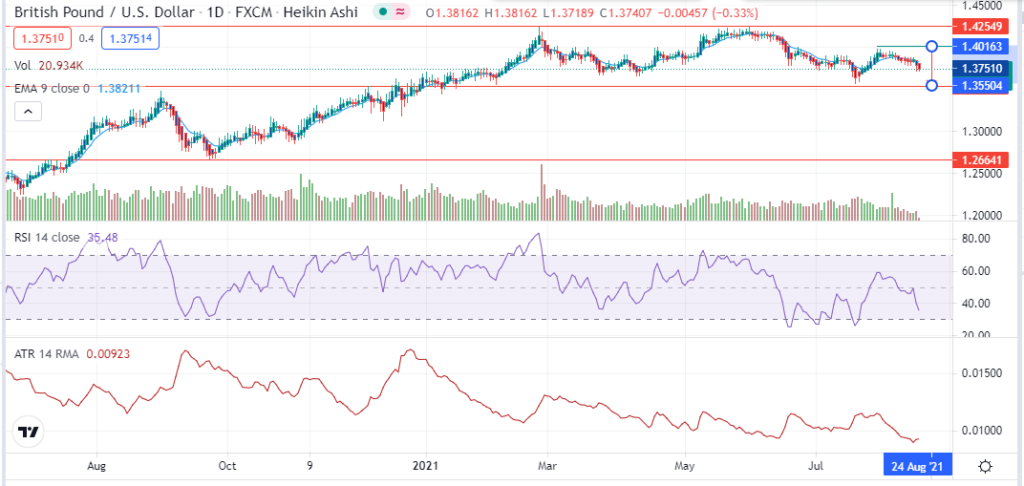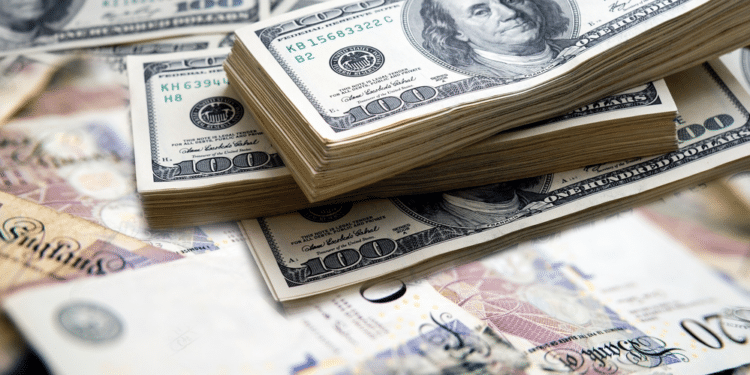- US capacity utilization rate for July 2021 rose 76.1% against June’s 75.4% increase.
- Business inventories in the US surged 0.8% in June 2021 from an increase of 0.6% realized in May 2021.
- The UK unemployment rate declined 4.7% in June 2021 against 4.8% in May 2021.
The GBPUSD pair traded to a 0.84% price change as of 4:00 pm GMT on August 17, 2021, from the previous day’s close. It fell from a high of 1.3855 to 1.3727 after the UK posted a decline in labor productivity at -0.5% from a previous increase of 0.4%.
As of 3:39 am GMT on August 18, 2021, the British pound had regained 0.05%.
Economic outlook
Investors felt confident that the US capacity utilization rate for July 2021 that rose 76.1% against June’s 75.4% increase. It rose above consensus estimates of 75.7%. This rating of 76.1% was 3.5% points higher than the average rating acquired from 1972-2020.
Additionally, the industrial production for July 2021 (MoM) also gained 0.9% from 0.2% recorded in June 2021. The month of July 2021 also saw the manufacturing output gain 1.4%. A large part of this output is attributed to an 11.2% increase in the production of motor vehicles/ parts.
An increase in industrial production was, however, curtailed by supply bottlenecks of semiconductors. July 2021 saw a 3.5% reduction in the production output of automobiles and vehicle parts as compared to its January 2021 highs.
However, manufacturing output increased by 1.4%. This increase in US factory output was attributed to an 11.2% increase in vehicle manufacturing and production of auto parts despite the semiconductor shortage.
Business indicators
Business inventories in the US surged 0.8% in June 2021 from an increase of 0.6% realized in May 2021. It rose to $2.0574 trillion from $2.0406 trillion in the previous month.
June 2021 also saw trade sales and manufacturers’ shipments (adjusted seasonally) rise 1.4% to $1.6408 trillion from May 2021. Sales were up 19.9% as compared to June 2021.
The inventory ratio against sales was 1.25 in June 2021 (-11.35%) from June 2020, where it stood at 1.41. A decrease of inventory against sales was a positive indicator in favor of the dollar as the restrictions continue to ease.
However, US retail sales for July 2021 (MoM) declined 1.0% from 1.4%. It failed to beat estimates at -0.1%, indicating a bearish turn for the dollar. On annual analysis, retail sales increased 15.78% in July 2021 against 18.73% recorded in July 2020.
UK unemployment
The UK is scheduled to release the house price index later on August 18, 2021. It stood at 10.0% in 2020. An increase in this index will positively impact the British pound.
In the UK, the unemployment rate declined 4.7% in June 2021 against 4.8% in May 2021. In July 2021, the payroll employee population soared 0.63% to 28.9 million, representing an increase of 182,000 from June 2021. However, this increase was still 201,000 (-0.69%) from its pre-Covid-19 levels, where it stood at 29.101 million.
On a seasonally adjusted basis (Q2 2021), the employment rate shot up 75.1% for the population age group 16-64 years. The quarter also saw the UK’s GDP rise 4.8% (up 6.4% points from the previous quarter).
Technical analysis
An increase in the house price index is likely to propel the pound higher. This scenario may initiate a rise towards 1.4255. However, first, the pair will have to break the support at 1.4016.

There is an increase in selling pressure, with the 14-day RSI moving towards the oversold region at 35.48. A possible downtrend may push prices to a low of 1.3550. Volatility is increasing with the 14-day ATR at 0.00923.







